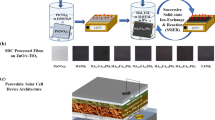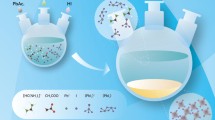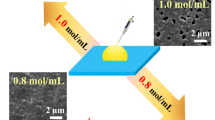Abstract
To date, extensive research has been carried out, with considerable success, on the development of high-performance perovskite solar cells (PSCs). Owing to its wide absorption range and remarkable thermal stability, the mixed-cation perovskite FAxMA1−xPbI3 (formamidinium/methylammonium lead iodide) promises high performance. However, the ratio of the mixed cations in the perovskite film has proved difficult to control with precursor solution. In addition, the FAxMA1−xPbI3 films contain a high percentage of MA+ and suffer from serious phase separation and high trap states, resulting in inferior photovoltaic performance. In this study, to suppress phase separation, a post-processing method was developed to partially nucleate before annealing, by treating the as-prepared intermediate phase FAI-PbI2-DMSO (DMSO: dimethylsulfoxide) with mixed FAI/MAI solution. It was found that in the final perovskite, FA0.92MA0.08PbI3, defects were substantially reduced because the analogous molecular structure initiated ion exchange in the post-processed thin perovskite films, which advanced partial nucleation. As a result, the increased light harvesting and reduced trap states contributed to the enhancement of open-circuit voltage and short-circuit current. The PSCs produced by the post-processing method presented reliable reproducibility, with a maximum power conversion efficiency of 20.80% and a degradation of ∼30% for 80 days in standard atmospheric conditions.
摘要
目前为止, 对于高性能钙钛矿太阳能电池(PSCs)的开发已经进行了大量的研究, 并取得了显著的成果. 基于FAxMA1−xPbI3的混合阳离子钙钛矿具有广泛的吸光范围和显著的热稳定性, 是获得高性能器件的理想材料. 然而, 很难通过前驱体来控制钙钛矿膜中 混合阳离子的比例. 此外, 高MA+含量的FAxMA1−xPbI3薄膜存在严重的相分离和大量的陷阱态, 导致光伏性能较差. 为了抑制相分离, 本文提出了一种退火前部分成核的后处理方法, 用混合的甲酰胺碘/甲铵碘(FAI/MAI)溶液处理制备的FAI-PbI2-DMSO中间相, 最终得到的钙钛矿为FA0.92MA0.08PbI3. 发现由于类似的分子结构引发了钙钛矿后处理薄膜中的离子交换, 从而促进了部分成核, 缺陷大大减少. 因此, 增加的光捕获和减少的缺陷态有助于提高开路电压和短路电流. 用后处理方法制备的PSCs在大气条件下, 最大PCE为20.80%, 80天后降解率为30%, 具有可靠的重现性.
Similar content being viewed by others
References
Kojima A, Teshima K, Shirai Y, et al. Organometal halide perovskites as visible-light sensitizers for photovoltaic cells. J Am Chem Soc, 2009, 131: 6050–6051
Song Z, Watthage SC, Phillips AB, et al. Impact of processing temperature and composition on the formation of methylammonium lead iodide perovskites. Chem Mater, 2015, 27: 4612–4619
Jeon NJ, Noh JH, Yang WS, et al. Compositional engineering of perovskite materials for high-performance solar cells. Nature, 2015, 517: 476–480
Meloni S, Moehl T, Tress W, et al. Ionic polarization-induced current-voltage hysteresis in CH3NH3PbX3 perovskite solar cells. Nat Commun, 2016, 7: 10334
Li L, Chen Y, Liu Z, et al. The additive coordination effect on hybrids perovskite crystallization and high-performance solar cell. Adv Mater, 2016, 28: 9862–9868
Eperon GE, Stranks SD, Menelaou C, et al. Formamidinium lead trihalide: A broadly tunable perovskite for efficient planar heterojunction solar cells. Energy Environ Sci, 2014, 7: 982
Guo L, Fei C, Zhang R, et al. Impact of sol aging on TiO2 compact layer and photovoltaic performance of perovskite solar cell. Sci China Mater, 2016, 59: 710–718
Long M, Zhang T, Liu M, et al. Abnormal synergetic effect of organic and halide ions on the stability and optoelectronic properties of a mixed perovskite via in situ characterizations. Adv Mater, 2018, 30: 1801562
Bi D, Luo J, Zhang F, et al. Morphology engineering: A route to highly reproducible and high efficiency perovskite solar cells. ChemSusChem, 2017, 10: 1624–1630
Lv S, Pang S, Zhou Y, et al. One-step, solution-processed for-mamidinium lead trihalide (FAPbI(3−x)Clx) for mesoscopic perovskite-polymer solar cells. Phys Chem Chem Phys, 2014, 16: 19206–19211
Li G, Zhang T, Guo N, et al. Ion-exchange-induced 2D–3D conversion of HMA1−xFAxPbI3Cl perovskite into a high-quality MA1−xFAxPbI3 perovskite. Angew Chem Int Ed, 2016, 55: 13460–13464
Yang M, Zhang T, Schulz P, et al. Facile fabrication of large-grain CH3NH3PbI3−xBrx films for high-efficiency solar cells via CH3NH3Br-selective Ostwald ripening. Nat Commun, 2016, 7: 12305
Xie F, Chen CC, Wu Y, et al. Vertical recrystallization for highly efficient and stable formamidinium-based inverted-structure perovskite solar cells. Energy Environ Sci, 2017, 10: 1942–1949
Wang F, Yu H, Xu H, et al. HPbI3: A new precursor compound for highly efficient solution-processed perovskite solar cells. Adv Funct Mater, 2015, 25: 1120–1126
Liu Y, Zhang H, Zhang Y, et al. Influence of hole transport layers on internal absorption, charge recombination and collection in HC(NH2)2PbI3 perovskite solar cells. J Mater Chem A, 2018, 6: 7922–7932
Bernard GM, Wasylishen RE, Ratcliffe CI, et al. Methylammonium cation dynamics in methylammonium lead halide perovskites: A solid-state NMR perspective. J Phys Chem A, 2018, 122: 1560–1573
Li C, Zhou Y, Wang L, et al. Methylammonium-mediated evolution of mixed-organic-cation perovskite thin films: A dynamic composition-tuning process. Angew Chem Int Ed, 2017, 56: 7674–7678
Hong X, Kang Y, Zhen C, et al. Maximizing the visible light photoelectrochemical activity of b/n-doped anatase TiO2 microspheres with exposed dominant {001} facets. Sci China Mater, 2018, 61: 831–838
Ren YK, Ding XH, Wu YH, et al. Temperature-assisted rapid nucleation: A facile method to optimize the film morphology for perovskite solar cells. J Mater Chem A, 2017, 5: 20327–20333
Zhang Y, Grancini G, Feng Y, et al. Optimization of stable quasicubic FAxMA1−xPbI3 perovskite structure for solar cells with efficiency beyond 20%. ACS Energy Lett, 2017, 2: 802–806
Sutherland BR, Johnston AK, Ip AH, et al. Sensitive, fast, and stable perovskite photodetectors exploiting interface engineering. ACS Photonics, 2015, 2: 1117–1123
Li Z, Yang M, Park JS, et al. Stabilizing perovskite structures by tuning tolerance factor: Formation of formamidinium and cesium lead iodide solid-state alloys. Chem Mater, 2015, 28: 284–292
Pool VL, Dou B, Van Campen DG, et al. Thermal engineering of FAPbI3 perovskite material via radiative thermal annealing and in situ XRD. Nat Commun, 2017, 8: 14075
Ren Y, Duan B, Xu Y, et al. New insight into solvent engineering technology from evolution of intermediates via one-step spin-coating approach. Sci China Mater, 2017, 60: 392–398
Stamplecoskie KG, Manser JS, Kamat PV. Dual nature of the excited state in organic-inorganic lead halide perovskites. Energy Environ Sci, 2015, 8: 208–215
Li C, Guo Q, Zhang H, et al. Enhancing the crystallinity of HC(NH2)2PbI3 film by incorporating methylammonium halide intermediate for efficient and stable perovskite solar cells. Nano Energy, 2017, 40: 248–257
Nie W, Tsai H, Asadpour R, et al. High-efficiency solution-processed perovskite solar cells with millimeter-scale grains. Science, 2015, 347: 522–525
Park M, Kornienko N, Reyes-Lillo SE, et al. Critical role of methylammonium librational motion in methylammonium lead iodide (CH3NH3PbI3) perovskite photochemistry. Nano Lett, 2017, 17: 4151–4157
Zhang T, Long M, Yan K, et al. Crystallinity preservation and ion migration suppression through dual ion exchange strategy for stable mixed perovskite solar cells. Adv Energy Mater, 2017, 7: 1700118
Sutherland BR, Sargent EH. Perovskite photonic sources. Nat Photon, 2016, 10: 295–302
Xiao X, Bao C, Fang Y, et al. Argon plasma treatment to tune perovskite surface composition for high efficiency solar cells and fast photodetectors. Adv Mater, 2018, 30: 1705176
Kubicki DJ, Prochowicz D, Hofstetter A, et al. Cation dynamics in mixed-cation (MA)x(FA)1−xPbI3 hybrid perovskites from solid-state NMR. J Am Chem Soc, 2017, 139: 10055–10061
Zhu W, Bao C, Wang Y, et al. Coarsening of one-step deposited organolead triiodide perovskite films via ostwald ripening for high efficiency planar-heterojunction solar cells. Dalton Trans, 2016, 45: 7856–7865
Isikgor FH, Li B, Zhu H, et al. High performance planar perovskite solar cells with a perovskite of mixed organic cations and mixed halides, MA1−xFAxPbI3−yCly. J Mater Chem A, 2016, 4: 12543–12553
Mu C, Pan J, Feng S, et al. Quantitative doping of chlorine in formamidinium lead trihalide (FAPbI3−xClx) for planar heterojunction perovskite solar cells. Adv Energy Mater, 2017, 7: 1601297
Zhou Y, Yang M, Pang S, et al. Exceptional morphology-preserving evolution of formamidinium lead triiodide perovskite thin films via organic-cation displacement. J Am Chem Soc, 2016, 138: 5535–5538
Zheng H, Dai S, Zhou K, et al. New-type highly stable 2D/3D perovskite materials: The effect of introducing ammonium cation on performance of perovskite solar cells. Sci China Mater, 2018, 62: 508–518
Ma S, Cai M, Cheng T, et al. Two-dimensional organic-inorganic hybrid perovskite: From material properties to device applications. Sci China Mater, 2018, 61: 1257–1277
Lee JW, Dai Z, Han TH, et al. 2D perovskite stabilized phase-pure formamidinium perovskite solar cells. Nat Commun, 2018, 9: 3021
Ma S, Qiao W, Cheng T, et al. Optical-electrical-chemical engineering of PEDOT:PSS by incorporation of hydrophobic nafion for efficient and stable perovskite solar cells. ACS Appl Mater Interfaces, 2018, 10: 3902–3911
Shi P, Ding Y, Ren Y, et al. Template-assisted formation of high-quality α-phase HC(NH2)2PbI3 perovskite solar cells. Adv Sci, 2019, 7: 1901591
Zhang L, Liu C, Zhang J, et al. Intensive exposure of functional rings of a polymeric hole-transporting material enables efficient perovskite solar cells. Adv Mater, 2018, 30: 1804028
Jeon NJ, Noh JH, Kim YC, et al. Solvent engineering for high-performance inorganic-organic hybrid perovskite solar cells. Nat Mater, 2014, 13: 897–903
Huang Y, Zhao Z, Wang C, et al. Conductive metallic filaments dominate in hybrid perovskite-based memory devices. Sci China Mater, 2019, 62: 1323–1331
Li J, Xu L, Wang T, et al. 50-Fold EQE improvement up to 6.27% of solution-processed all-inorganic perovskite CsPbBr3 QLEDs via surface ligand density control. Adv Mater, 2017, 29: 1603885
Shi X, Ding Y, Zhou S, et al. Enhanced interfacial binding and electron extraction using boron-doped TiO2 for highly efficient hysteresis-free perovskite solar cells. Adv Sci, 2019, 131: 1901213
Lin Y, Zhang Y, Guo Z, et al. Defects dynamics during ageing cycles of InGaN blue light-emitting diodes revealed by evolution of external quantum efficiency-current dependence. Opt Express, 2015, 23: A979–986
Jiang Q, Chu Z, Wang P, et al. Planar-structure perovskite solar cells with efficiency beyond 21%. Adv Mater, 2017, 29: 1703852
Zhu Z, Hadjiev VG, Rong Y, et al. Interaction of organic cation with water molecule in perovskite MAPbI3: From dynamic orientational disorder to hydrogen bonding. Chem Mater, 2016, 28: 7385–7393
Son DY, Kim SG, Seo JY, et al. Universal approach toward hysteresis-free perovskite solar cell via defect engineering. J Am Chem Soc, 2018, 140: 1358–1364
Shao Y, Xiao Z, Bi C, et al. Origin and elimination of photocurrent hysteresis by fullerene passivation in CH3NH3PBI3 planar heterojunction solar cells. Nat Commun, 2014, 5: 5784
Wang T, Zhang S, Wang H. Binary NiCu layered double hydroxide nanosheets for enhanced energy storage performance as supercapacitor electrode. Sci China Mater, 2017, 61: 296–302
Bai H, Shen T, Wang S, et al. Controlled growth of Cu3Se2 nanosheets array counter electrode for quantum dots sensitized solar cell through ion exchange. Sci China Mater, 2017, 60: 637–645
Shi X, Chen R, Jiang T, et al. Regulation of interfacial charge transfer and recombination for efficient planar perovskite solar cells. Sol RRL, 2019, 1900198
Wang Z, Wang L. Photoelectrode for water splitting: Materials, fabrication and characterization. Sci China Mater, 2018, 61: 806–821
Acknowledgements
The authors acknowledge support from the National Key Research and Development Program of China (2016YFA0202401), the 111 Project (B16016), the National Natural Science Foundation of China (51702096 and U1705256), the Fundamental Research Funds for the Central Universities (2018ZD07), and Metatest ScanPro Laser Scanning System.
Author information
Authors and Affiliations
Contributions
Author contributions Shi P mainly completed the experiment, measurements and wrote the manuscript; Ding Y instructed the experiment and revised the manuscript; Liu C helped with the experiment; Yang Y helped with drawing the figures. Arain Z revised the language; Cai M helped with analyzing the mechanism; Ren Y helped with the measurements; Hayat T and Alsaedi A checked the manuscript before submitting; Dai S handled the manuscript overall.
Corresponding authors
Ethics declarations
Conflict of interest The authors declare no conict of interest
Additional information
Pengju Shi obtained his BSc degree from North China Electric Power University in 2017. He is a Master candidate of the North China Electric Power University under the supervision of Prof. Songyuan Dai. His research interests mainly focus on perovskite solar cells.
Yong Ding received his PhD from Hefei Institutes of Physical Science, Chinese Academy of Sciences (CAS) in 2016. After graduation, he became a lecturer in North China Electric Power University (NCEPU). His research interest focuses on the 2D perovskite-based photoelectric devices, including perovskite solar cells and light-emitting diodes.
Molang Cai obtained her PhD degree in materials physics and chemistry from the Institute of Plasma Physics, CAS in 2013, studying interface engineering of dye sensitized solar cells. She was a postdoctoral researcher in Queensland University of Technology in 2013–2015, investigating electron transfer in perovskite solar cells. Since then, she has been working as a postdoctoral researcher in National Institute for Materials Science on performances of perovskite solar cells. Her research is focused on perovskite solar cells, dye-sensitized solar cells.
Songyuan Dai is a professor of the School of Renewable Energy, North China Electric Power University. He obtained his BSc degree in physics from Anhui Normal University in 1987, and MSc and PhD degrees in plasma physics from the Institute of Plasma Physics, CAS in 1991 and 2001, respectively. His research interests mainly focus on the next-generation solar cells including dye sensitized solar cells, quantum dot solar cells, perovskite solar cells, etc.
Electronic supplementary material
Rights and permissions
About this article
Cite this article
Shi, P., Ding, Y., Liu, C. et al. Advanced partial nucleation for single-phase FA0.92MA0.08PbI3-based high-efficiency perovskite solar cells. Sci. China Mater. 62, 1846–1856 (2019). https://doi.org/10.1007/s40843-019-1186-4
Received:
Accepted:
Published:
Issue Date:
DOI: https://doi.org/10.1007/s40843-019-1186-4




